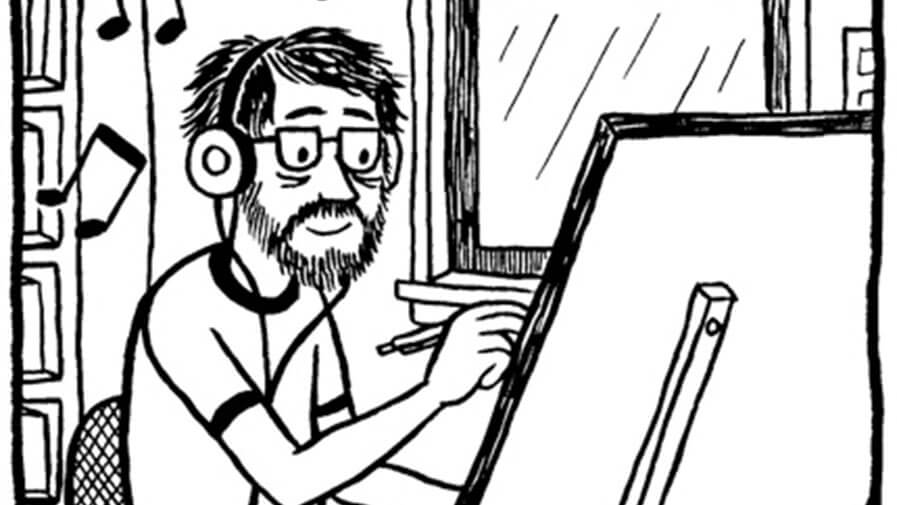


How to Read a Graphic Novel?
By Kanupriya Dingra, Official Jaipur Literature Festival Blogger
How to read a graphic novel? The question itself is misleading: the reader must go from panel to panel, and from bubble to bubble, using a layered cognition that requires much more interaction from the reader than simply reading words. There is an intake of shapes and figures, colors or of an absence of colors, spaces filled and unfilled, movements across space and time.
Graphic novel, categorically speaking, is a format rather than a genre, which came into existence as an accession of sorts to comics, an already existing form of literature. Both use sequential art to narrate a story, but whereas comics were mostly published in the form of magazines and pamphlets, this rather new and very popular form was published as books. It was called a novel because it had one continuous narrative to tell, from the first page to the last, with a plot, a core group of characters, and so on. The term ‘novel’ remains an unsettled term to ascribe to the format however, since the graphic novel is compatible not only for fiction but also non-fiction, fantasy, history et al.
Often, the age of readers has been used as a parameter to ascertain the difference between comics and graphic novels. The argument goes that comics have always been eligible to children, whereas graphic novels are a favourite for adults. However, this is debatable, since several comics include content and visual material that is also tailored for adults, such as Asterix and The Adventures of Tintin, and many graphic novels are loved by children, such as the Captain America series. As such, many view graphic novel as ‘crossover’, ‘young-adult’ or ‘kidult’ literature, read by and written for adults and children alike.
Marvel’s recent character-driven series Ms. Marvel, about Kamala Khan, a teenage Muslim girl living in Jersey with shape-shifting superpowers, is one of the most striking recent examples of the format. Kamala’s character belongs to the new generation of comics and graphic novels that break many conventions in this hitherto politically conservative milieu, a milieu most known for promoting white male heroes in masks, who save the country and its people from the evils that befall them.
Kamala’s character is a breakthrough in more ways than one. Her creators — editors Sana Amanat and Stephen Whacker, writer G. Willow Wilson and artist Adrian Alphona — state that they were careful not to reinforce cultural stereotypes in her characterization. As such, although Kamala’s character explores the Muslim-American diaspora from an authentic standpoint, she is primarily cast as an American teenager, struggling with an identity crisis, and faced with some profound choices.
How is a culturally informed character, not to mention a superhero, read and received in the graphic form, in such a way that readers feel she is ultimately one of them? Kamala Khan’s first appearance in August 2013 demonstrates an ever-evolving, diversifying comic-reading demographic in America. Yet characters from minority cultures – often under-represented or undermined in the mainstream – inevitably encounter extra scrutiny from their readers. It is a challenge for publishers to ascertain the balance between a reader’s apprehension of the unfamiliar, and a minority character’s representation, so that she can be ‘read’ positively. Furthermore, the graphic novel format itself still encounters additional scrutiny as a relatively new style of storytelling. It is said that the format’s success is due to its ability to attract ‘reluctant’ readers with its visual nature and culturally relevant content.
The term ‘graphic novel’ was coined by fan historian Richard Kyle, but it was only in the late 1980s that it became familiar to the public, after the commercial success of Volume 1 of Art Spiegelman’s Maus in 1986 and the collected editions of Frank Miller’s The Dark Knight Returns. It wasn’t until 2001 when the format really hit the bookstores. Certain experiments continue to challenge conventions. At Columbia University in 2014, Walter Nickell Sousanis became the first person to both write and draw a dissertation in graphic novel form. It went on to become a book called Unflattening, published by Harvard University Press. In his dissertation, Sousanis argues for the significance of ‘visual thinking’ in teaching and learning.
On the whole, the totality of what must be imagined when reading a novel, comes alive on the page when it comes to a graphic novel. To read a graphic novel is not enough: you must enter it with all your senses, and let it enter you.
© KanupriyaDhingra, 2016
Like this blog? Find more interesting blogs about the Jaipur Literature Festival in Jaipur too! Click here.
Disclaimer: We do not endorse, support or subscribe for any statement, view or comment expressed or posted on this blog or social media page. Any view, statement or comment posted on this platform does not represent the views of Teamwork Arts, its affiliates or its employees or any person associate with Jaipur Literature Festival (JLF), unless specifically stated otherwise.



Leave a comment